|
JLT Mobile JLT6012A
Compact, rugged Android-based 12.1-inch vehicle-mount computer with capacitive multi-touch
(by Conrad H. Blickenstorfer)
The JLT6012A from Swedish JLT Mobile Computers is a rugged vehicle mount PC for mobile IT and logistics solutions. What sets the JLT6012A apart from the vast majority of such systems is that inside its virtually indestructible housing with all the ports and connectivity required for a rough life on the road is a modern Android device.
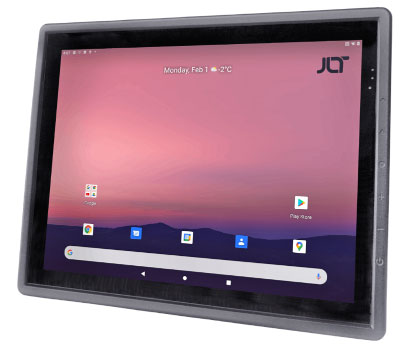
Yes, JLT Mobile Computers is giving its customers the choice of having this ultra-rugged 12-inch vehicle-mount in either a version running Windows 10 or one running Android 10. Why would the company that has been a leading supplier of rugged mobile computing devices and solutions for over a quarter of a century do that?
Per Holmberg, CEO of JLT Mobile Computers, has the logical answer. "Android is the world's leading operating platform and billions of people are familiar with it and use it every day," he said. "Many customers in our markets would love to use it in their business but they shy away because most Android devices aren't designed and built for work and use in harsh environments. That's where our new JLT6012A comes in."
The design and initial release of the JLT6012 actually goes back to 2018 when JLT launched the platform as the first product of a next generation of rugged vehicle mount computers for the needs of a changing world. To be ready for that changing world, the JLT6012 not only came with capacitive multi-touch — which was still rare in rugged systems back in 2018 — but, in addition to Windows 10 IoT, could also run Android. The way the company saw it, that meant state-of-the-art support of any Windows ecosystem, but also the kind of instant familiarity to virtually anyone who has a smartphone.
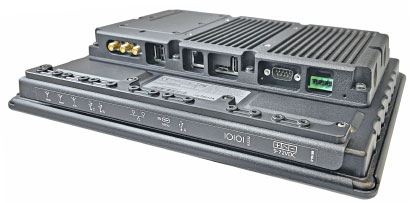
The JLT6012 went on to become the fastest ramping product in JLT history. We don't, however, know what the sales split was between Windows and Android versions, and there was likely also no way for JLT to predict what that split would be.
To manage that uncertainty, they hedged their bet by using the same hardware for the Windows and the Android version. That's possible and other companies have done it but it is, on the Android side, a compromise. That's because Android was designed to run on ARM processors and Windows on x86 processors.
The Atom E3845 that was initially used for both OS versions is one of Intel's workhorse processors widely used in industrial and vertical market systems, but it's definitely a chip built for Windows and not for Android. The E3845 certainly got the job done on Android as well (the very successful Xplore XSlate D10 rugged tablet used it), but it is not an Android chip and it was introduced over eight years ago.
The new JLT6012A fixes that whole dilemma. The Android version of the panel is now a through-and-through Android design running on a Qualcomm Snapdragon processor, the same chip family that powers the majority of mid- and high-end Android smartphones.
The JLT6012 platform
But on to a description of the JLT6012A. As far as size and bulk go, it is quite compact compared to most vehicle computers. Its 11.5 x 9.1 inch footprint is barely larger than that of a 12.9-inch iPad Pro. It's thicker, of course, what with a full complement of ports and this being a very rugged device. Despite the ruggedness it weighs a for vehicle mounts modest 6.5 pounds.
The panel's display measures 12.1 inches diagonally and offers 1024 x 768 pixel video in the 4:3 aspect ratio format. That makes for 106 ppi (pixels per inch), not much in this day and age of hyper-sharp smartphones and tablets, but plenty good enough for vehicle use. JLT offers the screen in two brightness levels, 500 and 1,000 nits. 500 nits is roughly what you get in a good smartphone or consumer tablet, 1,000+ is usually only available on rugged tablets or laptops for outdoor use.
The JLT6012A also features the company's "PowerTouch" technology, which provides a user-friendly experience comparable to modern consumer devices — both with a gloved and ungloved hand — while being virtually unbreakable.
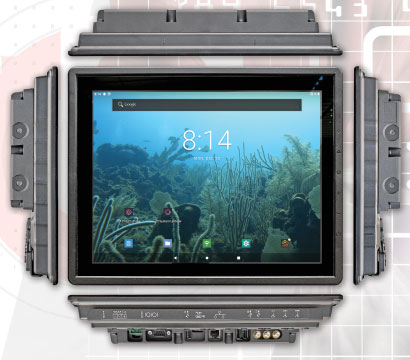
For technology the new JLT6012A offers a mix of consumer and industrial technology. The octa-core 2.2GHz Snapdragon SD660 processor is part of Qualcomm's family of mobile "systems on a chip" (SoC) line.  The SD660 is used in numerous smartphones, and it has also become something like the processor of choice in leading rugged handhelds and tablets. It's a fast mid-range chip that uses a 64-bit CPU architecture and runs on four ARM Cortex 73 cores (delivering high performance) and four ARM Cortex A53 cores (for when economy matters). For graphics, the SDS660 includes an Adreno 512 GPU that supports all the features that count in this class of mobile computer. The SD660 is used in numerous smartphones, and it has also become something like the processor of choice in leading rugged handhelds and tablets. It's a fast mid-range chip that uses a 64-bit CPU architecture and runs on four ARM Cortex 73 cores (delivering high performance) and four ARM Cortex A53 cores (for when economy matters). For graphics, the SDS660 includes an Adreno 512 GPU that supports all the features that count in this class of mobile computer.
There is 4GB of LPDDR4 RAM and 64GB of internal eMMC storage. The JLT6012A also has an SD card slot that supports the SDXC standard for cards up to 2TB.
Among RF options are WLAN 802.11 ac or 802.11 a/b/g/n with dual diversity antennas as well as Bluetooth 5 BLE (BLE stands for Bluetooth Low Energy and supports earlier versions of Bluetooth as well as the newer low energy protocols). Bluetooth 5 also has twice the data throughput, a long range mode (up to 800 feet), and improved connectivity. The JLT6012A also optionally supports mobile broadband and GNSS (GPS, Glonass, Galileo, BeiDou). There are three ports for external WWAN and GNSS or WLAN
and Bluetooth antennas. There is also NFC for quick and easy login and identification.
The JLT6012A has rich onboard wired connectivity. There are three USB 2.0 ports for peripherals, a USB 3.1 reversible Type-C port that supports OTG as well as DisplayPort for an external display, a gigabit Ethernet port, and a legacy RS232 serial port. 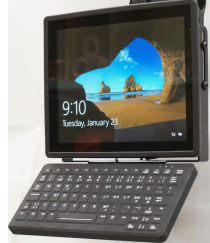 The panel also has a cable strain relief plate and rubber sealing plugs for unused ports. A keyboard mount plate (shown to the right) is optional. The panel also has a cable strain relief plate and rubber sealing plugs for unused ports. A keyboard mount plate (shown to the right) is optional.
Unlike most panel computers, the JLT6012A has not only an ambient light sensor, but also gyro and accelerometer. More sensor data is always good for new and innovative solutions.
As a vehicle-mount, the JLT6012A uses VDC power. It can handle a very wide range of 9 to 72 Volt; no need for cumbersome external adapters in most cases. A UPC can handle graceful shutdown and onboard power fluctuations.
Performance
As far as performance and responsiveness goes, the switch from the original processor in the dual-OS version of the JLT6012 to the Qualcomm SnapDragon SD660 in the dedicated JLT6012A Android version is a big step forward.
|
Company
|
JLT Mobile
|
|
|
Model (version tested)
|
JLT6012A
|
|
Year tested
|
2021
|
|
Processor
|
Qualcomm SnapDragon
|
|
Processor Model
|
SD660
|
|
CPU Speed
|
1.90GHZ & 2.20GHz
|
|
Cores
|
Octa-core (4 x Cortex A53, 4 x Cortex 73)
|
|
PCMark for Android
|
6756
|
|
AnTuTu Overall
|
182979
|
|
Velamo Metal
|
3064
|
|
Velamo Multicore
|
3302
|
|
Vellamo Browser
|
5490
|
|
GeekBench 5 Single Core
|
335
|
|
GeekBench 5 Multi Core
|
1635
|
|
GeekBench 5 Open CL
|
634
|
RuggedPCReview's benchmark database suggests a massive 4x leap in the AnTuTu benchmark suite, a 2x performance increase in the Vellamo benchmarks, and PCMark for Android results beating such prominent rugged tablets as the Panasonic Toughbook A3. That's impressive.
In essence, the switch to the SnapDragon SD660 put the JLT6012A among the performance leaders in the ultra-rugged Android-based vehicle-mount computer category. That said, by modern smartphone standards, the Snapdragon 660 is no longer new, but as of late 2021 it remains at the forefront of what's available in dedicated and truly rugged Android devices.
Display and interface
There are two things that matter above all else for a vehicle mount computer's display. First, it must be bright enough to be viewable under all expected lighting conditions. And, second, it must not break. As far as the first condition goes, the JLT6012A comes standard with a 500 nits display, but JLT also offers an optional 1000 nits version. Our eval unit came with the default display which, in our luminance testing, outperformed the spec with a very good 627 nits reading.

As far as break-resistance goes, JLT prides itself in its JLT PowerTouch technology that can withstand the impact of a one pound steel ball dropped from a height of four feet onto the display without any damage. Further, JLT PowerTouch uses a grid of virtually invisible wires embedded in the sensor that, in conjunction with hardened glass, eliminates scratching. Add to that control firmware that filters out false touches, water droplets, or even water spilled onto the screen.
Horizontal viewing angles are very good, vertical ones less so, but that's generally not much of an issue in vehicle-mounts that can be positioned for optimal viewing.
As far as the interface goes, the JLT6012A is touch-operated, but also has capacitive touch areas built into the right side of the computer. They are on/off, brightness up/down, and the three standard Android buttons. Labels for buttons are imprinted onto the unit's snap-on protective bezel, which means that custom bezels with custom function labels seem possible.
Ruggedness and build
Vehicle-mounts must be tough as nail. They may not get dropped like mobile tablets or handhelds, but they must be able to handle brutal jolts and vibration, as well as temperature extremes. So the JLT6012A's environmental specs include a very wide -22 to 131 degree Fahrenheit operating temperature range, compliance with IEC 60068-2-64 vibration testing and IEC 60068-2-27 shock testing, and an IP65 sealing rating where the "6" means the tablet is totally dustproof, and the "5" that it can also handle low pressure water jets from all directions.
Impressive though those ruggedness specs are, they can't convey just how solid and trust-inspiring the JLT6012A feels, and how meticulously engineered and built the panel is inside. This is craftsmanship of the highest grade. The image below shows the inside of the JLT6012A (click on it for a larger image).
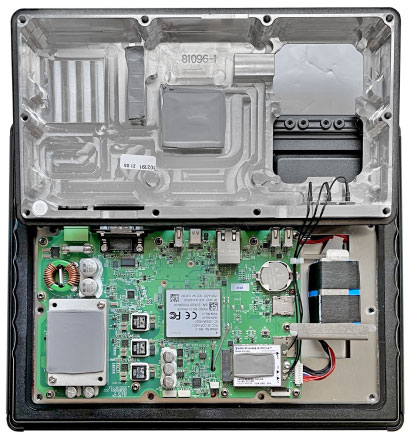
Note details such as the clean design, the use of silicone glue to keep components from rattling loose even under constant vibration, the thermal pads that conduct heat to the thick housing that serves as a very effective heat dissipator, or the ease with which internal UPS battery can be accessed or replaced. Near the battery, also notice the internal micro-SIM and micro-SD card slots.
Dawn of a new era: Android in vehicle-mounts
Not so very long ago, virtually every vehicle computer ran Windows. That's changed. Enterprise systems and desktops still mostly run Windows, but almost all smartphones and a good many tablets run Android now.
So it makes perfect sense to offer the same tough vehicle computer platform with the choice of Windows 10 as well as with Android, the OS that was designed for touch and user-friendly operation from the start, and which is familiar to almost everyone by now. And it also makes perfect sense to give each version the processor and electronics to make it shine.
JLT Mobile's JLT6012A merges the quality and toughness of an ultra-rugged vehicle-mount with the flexibility and ease of use of a modern Android smartphone -- Conrad H. Blickenstorfer, December 2021
|



